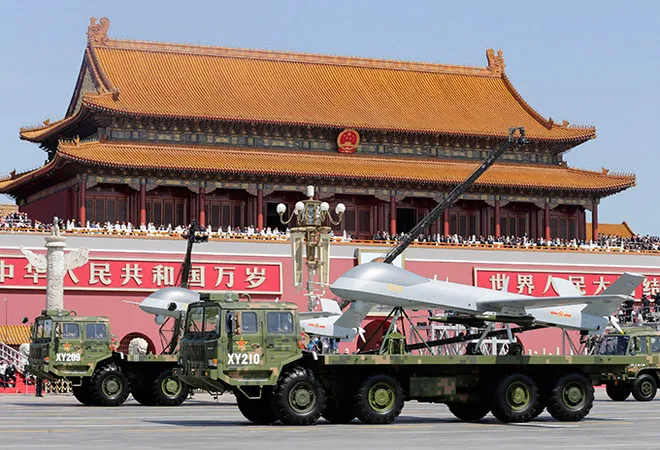
Since 2010, China’s People’s Liberation Army Air Force (PLAAF) has undergone rapid modernisation and capability growth, posing an increasingly serious challenge to the established capabilities of the Japan Air Self Defence Force (JASDF), the Indian Air Force (IAF) and US Indo-Pacific Command assets. A core part of this modernisation has involved developing a range of modern, multirole fighter aircraft, modern sensors, air-launched munitions and datalinks. <1> However, the active development of survivable, low-observable unmanned air systems (UAS) is one aspect of PLAAF modernisation that has typically received less attention than fast jets.
China has developed a wide range of UAS in the remotely piloted air system (RPAS) category, such as the CH-4, Wing Loong and Wing Loong II. However, RPASs such as these are generally unsuitable for state-on-state warfighting because they rely on either direct radio-line-of-sight or satellite communications up/downlinks for control in flight. Both control mechanisms are relatively easy for modern state adversaries to detect, disrupt and/or override using electronic warfare equipment. <2> As a result, UAS designed for operations in high-intensity warfighting scenarios against modern military forces are often grouped into a separate class of weapon systems — unmanned combat aerial vehicles (UCAVs). To be clear, UCAVs are different from RPAS such as the Wing Loong or MQ-9 Reaper. Unlike those systems, UCAVs are designed with very low-observable features to minimise radar and heat signatures, and fly pre-programmed sorties with a high-degree of in-flight autonomy to be able to operate in heavy-electronic warfare conditions. They offer considerable advantages compared to piloted aircraft in certain mission sets.
To be clear, UCAVs are different from RPAS such as the Wing Loong or MQ-9 Reaper.
True UCAVs fly pre-programmed missions with operators to monitor, authorise and re-task them in flight when connectivity allows, rather than being remotely flown. As such, they require trained operators, but not pilots in the traditional sense. This is highly significant, since it reduces the requirement for airframes to train new pilots, and to provide pilots in frontline units with regular training flying hours to maintain currency. A high proportion of the expensive hours flown by fast jets is for pilot training rather than for major exercises or live operations. Without this requirement, a UCAV force will be significantly cheaper to operate and the airframes themselves could be built to lower structural fatigue life standards, saving weight and cost. High-level automation is unlikely to be sufficiently advanced to allow UCAVs to perform many of the peacetime missions currently conducted by combat aircraft — especially quick reaction alert scrambles, airspace probing and close-air support of friendly ground forces — for the foreseeable future. However, for high-intensity mission sets where rules of engagement and target identification parameters are relatively straightforward, such as suppressing enemy air defences, deep strike against fixed targets and even offensive counter-air missions in a major conflict, UCAV technology is extremely promising.
Leaked information suggests that multiple different potential UCAV programmes are supposedly being developed for the PLAAF. The first, and seemingly most mature, is the Hongdu GJ-11. GJ stands for gōng jī, which roughly translates to ‘attack,’ suggesting that penetrating strike is the intended primary role. The GJ-11 has been in flight testing since at least 2013, and a mock-up with significantly improved stealth features was shown off at the 70th-anniversary parade of the Chinese Communist Party (CCP) in 2019. <3> The airframe is a flying wing design with a single buried engine, most likely with subsonic performance and provision for internal weapons in the 2000lb class. <4> Given an efficient turbofan powerplant and its low drag configuration, an operational GJ-11 will most likely have an impressive range on internal fuel — sufficient to threaten targets far from the Chinese mainland. Furthermore, the tailless flying wing shape offers the potential for broadband all-aspect stealth, far beyond current possibilities for stealth fighters such as the J-20A. This, however, requires Chinese manufacturers to solve the many engineering difficulties inherent in mounting low probability of intercept/detect sensors, heat exchangers and communications arrays within a clean operational airframe. To have a credible strike capability against defended American, Japanese or Indian targets at reach will also require the ability to fly to those targets, scan for and detect key aiming points, and release weapons within guidance parameters without real-time human control. While such levels of lethal autonomy in flight might sound extremely radical, the fact remains that modern cruise missiles, loitering munitions and anti-ship missiles have had similar autonomous navigation, target acquisition, prioritisation and attack capabilities for well over a decade. The CCP’s enthusiastic development of artificial intelligence technologies in multiple defence and security fields, and determination to close the military capability gap with the US in the Indo-Pacific mean that the country is unlikely to restrict itself from developing promising, cheap and capable strike UCAVs with these capabilities on the basis of ethical or legal concerns.
Leaked information suggests that multiple different potential UCAV programmes are supposedly being developed for the PLAAF.
In addition to the GJ-11, several other outwardly similar flying-wing or cranked kite demonstrators and mock-ups have been displayed or leaked in recent years, including the China Aerospace Science and Industry Corporation Tian Ying and China Aerospace Science and Technology Corporation CH-7. <5> These offer additional pathways to be developed into viable low-observable strike and/or intelligence, surveillance and reconnaissance (ISR) UCAVs, with some indications that the Tian Ying in particular might be considered for operations off future catapult take-off but arrested recovery aircraft carrier designs. <6> The US Navy has already shown that carrier operations are possible for this class of vehicle in trials with the Northrop Grumman X-47B cranked kite UCAV demonstrator. <7> Having multiple parallel UCAV development programmes being undertaken by different aerospace manufacturers is well in line with Chinese practice across a range of other weapons systems. With few limits on funding availability, this approach maximises the likelihood of viable operational capabilities being produced, even if some fail to meet the required standards. This multiple-track development approach also increases the likelihood that at least some Chinese UCAV designs will find buyers on the export market in the Indo-Pacific and beyond, just like the CH-4 and Wing Loong series RPAS.
A wild card is the so-called ‘Dark Sword’ UCAV, which may or may not be an actual development programme. The UCAV was teased in a supposedly leaked photograph showing what appeared to be a demonstrator airframe or mock-up shaped for agility and supersonic flight. <8> Such a design could enable a UCAV to match traditional fast jets’ performance and flight characteristics more easily, suggesting that the Dark Sword could be a prototype ‘loyal wingman’ system intended to operate alongside piloted fast jets to provide additional weapons, sensors and tactical options in combat. However, no significant further information has been disclosed about the project, so the leaked photograph could simply have been a mock-up designed to mislead foreign intelligence services. On the other hand, loyal wingman type UCAV development programmes are underway in Australia, the US and the UK, suggesting that the Dark Sword will not be a technological outlier if it is indeed a genuine programme. <9><10><11>
A wild card is the so-called ‘Dark Sword’ UCAV, which may or may not be an actual development programme.
The clear conclusion is that, within the coming decade, the PLAAF and possibly the People’s Liberation Army Naval Air Force will begin to field several operational UCAV designs with significant degrees of lethal automation and broadband stealth for strike, ISR and potentially offensive counter-air operations in highly contested airspace. These assets are unlikely to match the flexibility and raw combat power of the latest fast jet designs but will be significantly cheaper to build and operate. They are also likely to be considerably easier to train operators for than piloted fast jets, further removing barriers to rapid force growth. Whilst countries threatened by Chinese military developments might not wish to develop armed UCAV capabilities, they will need to have credible military solutions to a PLAAF that fields them at scale.
This essay originally appeared in the GP-ORF publication —
The Future of War in South Asia: Innovation, Technology and Organisation.
Endnotes
<1> Justin Bronk, “Russian and Chinese Combat Air Trends: Current Capabilities and Future Threat Outlook,” RUSI Whitehall Reports, October 30, 2020.
<2> The Iranian capture of a US Air Force RQ-170 Sentinel stealth ISR RPAS in 2011 is an excellent example of this vulnerability: John Keller, “Iran–U.S. RQ-170 incident has defense industry saying 'never again' to unmanned vehicle hacking,” Military & Aerospace Electronics, May 3, 2016.
<3> Joseph Trevithick, “China Showcases Stealthier Sharp Sword Unmanned Combat Air Vehicle Configuration,” The Warzone, October 1, 2019.
<4> Andreas Rupprecht, Modern Chinese Warplanes (Houston, TX: Harpia, 2020), p. 105.
<5> Joseph Trevithick and Tyler Rogoway, “China's Biggest Airshow Offers More Evidence Of Beijing's Stealth Drone Focus,” The Warzone, November 2, 2018.
<6> Tyler Rogoway, “China's Reported Plan To Deploy Weaponless Stealth Drones On Its Carriers Make Perfect Sense,” The Warzone, September 25, 2019.
<7> Northrop Grumman, "X-47B UCAS Makes Aviation History…Again”.
<8> Chen Chuanren, “China Reveals a Supersonic UCAV,” AIN Online, June 12, 2018.
<9> Greg Waldron, “Boeing Australia ‘loyal wingman’ conducts first taxi test,” Flight Global, October 22, 2020.
<10> Garrett Reim, “US Air Force launches Skyborg competition, artificial intelligence for loyal wingman UAV,” Flight Global, May 18, 2020.
<11> Craig Hoyle, “Dstl nears decision on LANCA flight demonstration for UK,” Flight Global, June 30, 2020.
The views expressed above belong to the author(s). ORF research and analyses now available on Telegram! Click here to access our curated content — blogs, longforms and interviews.




 PREV
PREV

